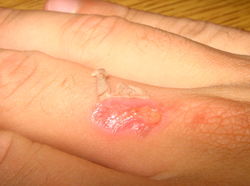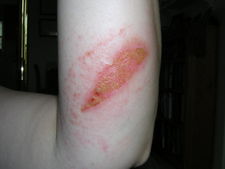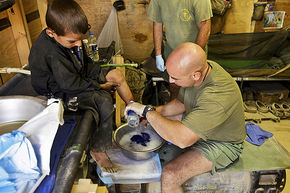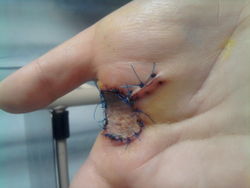Burn injury
A burn injury occurs when skin or deeper tissues are damaged by sun, fire, electricity, or chemicals. The injury can be broken down into three categories known as 1st, 2nd, or 3rd degree in severity. These each have their unique characteristics and treatments. First degree burns are only superficial, and often require little treatment. A second degree burn is much more painful and should be taken care of more tenderly. Third degree burns are the most severe, and often require surgery to heal. Third degree burn victims often receive skin grafts. These transplants move healthy skin from another part of the body to the burn site. Many different occurrences could cause a burn. Whether it be by liquids, the sun, or chemicals, people could become burned in many different ways.
Causes
There are several categories that burns may be classified into. These include scalds, contact burns, chemical burns, electrical burns, friction burns, and radiation burns. [1] When someone burns themselves on a hot liquid, this is considered a scald burn. This may occur when spilling hot coffee or boiling water. If someone puts their hand on a hot stove, or into the flame of a fire or a lighter, this is called a contact burn. Chemical burns result from swallowing or coming in contact with dangerous chemicals. These may occur on the skin, or inside the body. If a human is struck by lightning, or is electrocuted, then they would receive an electrical burn. Friction burns are quite well known. They occur when the skin rubs against another hard surface, like carpet or asphalt. These are known also as "rug burns" or "road rash". Friction burns are not just burns but also scrapes. This may also happen with surfaces like gym floors or tracks.[2] The most common burns, sun burns, are also considered to be radiation burns. This is because the sun is a source of radiation. All of these burns occur from overexposure to radiation. [3]
Types and Characteristics
1st Degree First degree burns can also be known as superficial burns. These epidermis level burns will grow to be usually red and swollen. The burn area may look and feel very dry or crusty to the touch. [4] They normally heal rather quickly, and the patient will not retain a scar where the burn had been. [3]
2nd Degree
Second degree burns can be divided into two different categories. These burns may affect the epidermis and the dermis. If only the upper part of the dermis is damaged, the burn is "superficial partial-thickness". These may be slightly red or pink, and will be sensitive to the air. If the burn causes damage deeper into the dermis, then it has become a "deep partial-thickness" burn. These will be very sensitive to any type of touch or pressure. The color of these will vary, from white and blotchy, to deep red. [4] Overall, second degree burns can be classified as partial-thickness burns. Because second degree burns may be divided into two categories, some may consider there to be four types of burns. [3]
3rd Degree
Third degree burns, or otherwise known as "full-thickness" burns, damage the epidermis, dermis, as well as the hypo-dermis. More than skin, these burns could damage tendons, bones, and possibly even nerves.[3] The appearance of this burn may vary depending on the cause or the area which was burned. The area may become white, gray, or maybe even black. The burn may look charred or leathery as well after the damage. The surface will look dry and tight, and the skin will not move or blanch (become white) when touched.[4]
Treatments
1st Degree
Treatment for a first degree burn is often not extensive and rather easy. After getting a first degree burn, running the area under cool water is advised. Patients might also be instructed to place a cool, dampened cloth over the burn. Some may even receive medication, or over-the-counter ointments, if the burn is particularly bothersome or difficult to treat effectively. Sun burns are a good example of a minor burn that can be treated with cooling gels such as aloe. Aloe can also be used for any other kind of first degree burn. The ingredients will sooth and decrease the sensitivity of the burn. Superficial burns such as these, because they only damage is to the epidermis, do not cause any scarring. [3]
2nd Degree
If a second degree burn has damaged a deep part of the dermis, scarring may occur. However, if the burn only touches the upper part of the dermis, there is a chance that it will not scar. If the injury is particularly bad, some doctors may utilize skin-grafts to repair the skin. A patient may be able to decipher the depth of his or her injury by keeping track of how long the burn takes to fully heal itself. A "superficial partial-thickness" burn will be fully recovered in three weeks or less. However, if the burn damages deeper parts of the dermis, a "deep-partial thickness" burn, the healing time may be slightly longer, possibly around four to five weeks. Blisters may be another affect of this burn. A patient should never pop their blisters. If the blisters are punctured or ruptured, infection may occur. [3]
3rd Degree
Third degree burns are never painful, because the burn has traveled so deep it has damaged the nerves of the area. Surgery is often required for these injuries to heal at all. The area cannot close to heal itself without being surgically worked on. They often cause permanent damage to the skin, even if the doctor uses a skin-grafting technique. The area will also probably be disfigured without hope of reconstruction, in most cases. If the burn is not looked at and treated by a physician immediately, the patient may be at risk of death. Infection may occur rapidly, which will cause complications even if treatment is almost immediate. [3]
Skin Graft
A skin graft is a common procedure done to help a burn heal. Burn victims will often get skin grafts when the burn has permanently damaged the skin so deeply that the body is no longer protected. Skin grafts are preformed in hospitals when a layer of skin is taken from a healthy part of the body, and moved and transplanted to the damaged portion. The portion of the body from which skin is taken can also be referred to as the "donor site". [5]
Similar to how there are different types of burns, patients may receive two different types of skin grafts, depending upon their injury. If the patient requires a skin graft to cover a larger portion of their skin, they should receive a split-level thickness graft. These transplants will not begin to grow with the surrounding skin once places, so they may grow paler than the surrounding area. After receiving this graft surgery, the doctor will analyze your progress for only a few days. If the patient is burned on a very visible part of the body, such as the face or the neck, doctors will recommend a full-thickness graft. During these procedures, the doctor will remove from the donor site not only skin, but muscle and blood vessels as well. Because these grafts are for high-visibility areas, they are designed to blend well with the skin, much better than split-level thickness grafts. After this procedure, though, the patient will experience a severe amount of pain, and will need to stay in treatment for a couple weeks. [5]
Video
A summary of the different types of burns and how to care for them.
References
- ↑ Burns. Mayo Clinic. Web. 12 January 2015 (Date Accessed).
- ↑ Burns and Electric Shock. WebMD. Web. 28 January 2015 (Date-Accessed). Unknown Author.
- ↑ 3.0 3.1 3.2 3.3 3.4 3.5 3.6 Types of Burns Types of Burns. Web. 12 January 2015 (Date-Accessed).
- ↑ 4.0 4.1 4.2 Ambulatory management of burns Med India. Web. 12 January 2015 (Date-Accessed).
- ↑ 5.0 5.1 Krucik, George. Skin Graft. Healthline. Web. 23 July 2012 (Date-Published).
| ||||||||||||||||||||




